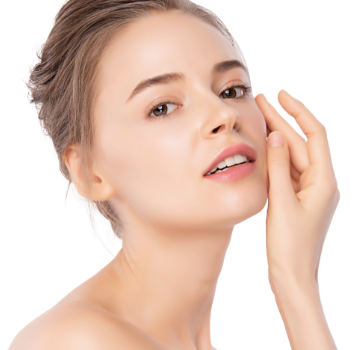The skin surrounding the eyes is one of the most intricate and active areas of the face. It performs constant movement, blinking, squinting, and expression – while also being among the thinnest skin on the body. This combination makes it uniquely susceptible to visible change over time.
The skin here contains fewer oil glands, less structural fat, and a reduced collagen network, meaning it has a lower capacity to retain moisture and cushion against daily motion.
Environmental factors such as sunlight, sleep patterns, and even eye strain can further influence its appearance and comfort.
Because of these characteristics, this area often requires a more cautious and clinically informed approach. An Under-Eye Skin Consultation provides the opportunity to understand these differences in depth, evaluate your individual skin needs, and discuss evidence-based, non-surgical strategies to support this delicate region.
Factors That May Influence Under-Eye Skin
During your consultation, your clinician will discuss how multiple biological and lifestyle factors can contribute to changes in the under-eye area, such as:
Anatomical structure: Thin skin and limited soft-tissue support can make this area appear more delicate.
Hydration levels: The skin’s reduced oil production and barrier function can make dehydration more noticeable.
Movement and expression: Frequent muscle motion from blinking and facial expression can affect surface texture.
Circulation and fluid balance: The lymphatic and vascular systems under the eyes play a role in tone and puffiness.
External influences: Sun exposure, digital screen use, environmental stressors, and sleep habits can impact skin comfort and balance.
Understanding these factors helps guide appropriate care discussions under medical supervision.

Your Consultation at Shellharbour Skin
Your consultation is a structured, discussion-based appointment designed to help you understand your skin and make informed choices about its care.
During this appointment, your clinician will:
- Assess the under-eye area for hydration, elasticity, and overall health.
- Review your medical history, medications, allergies, and relevant lifestyle factors.
- Discuss your individual concerns and expectations.
- Provide education on the anatomy and physiology of under-eye skin and how it differs from other facial areas.
- Outline clinically appropriate, non-surgical approaches that may be discussed following assessment.
- Explain the consent process, including preparation, safety, and after-care considerations.
No procedure or topical application proceeds without a medical assessment and informed consent.
This ensures your comfort, safety, and understanding remain at the centre of your care.
Approach Discussions
After your assessment, your clinician may outline management or care pathways suited to your needs.
These discussions are educational and focused on safe, evidence-informed options within a medically supervised environment.
Topics may include:
- Observation or monitoring, when no immediate intervention is required.
- Skin health optimisation, including home-care routines, hydration support, and sun protection.
- Professional in-clinic treatments, such as light-based therapy, gentle resurfacing, or targeted facials, where appropriate. Examples may include Alma Hybrid CO₂, BBL (BroadBand Light), or Ultraformer MPT (HIFU)—discussed based on your individual assessment.
- Prescribed medication approaches, where clinically indicated and only following an in-person assessment by a medical practitioner.
- These discussions may explore how certain prescribed topical or injectable medicines can support skin function when appropriate.
- All prescription decisions are made by an authorised prescriber, based on your medical history, health status, and clinical suitability.
- Collaborative or referred care, if additional medical or allied input is recommended.
No treatment proceeds without a comprehensive clinical assessment and documented informed consent.
Your clinician will explain the reasoning behind any recommendation, as well as relevant risks, safety measures, and after-care guidance.
After-Consultation Considerations
If a professional treatment or care plan is discussed, you will receive written information about:
- Expected recovery and follow-up review timing
- Temporary care instructions
- How to monitor the skin and when to contact the clinic for further assessment
You are encouraged to take time to review all provided information before making any decision.
Risks and Precautions
All aesthetic and clinical treatments carry some level of risk.Your clinician will explain these risks in detail, including how they are minimised in a supervised setting.
Common temporary effects may include mild redness, swelling, or sensitivity.
Less common effects such as bruising or irritation are also discussed during your consultation as part of the consent process.
Cost and Planning
Consultation fees vary depending on the time and complexity of your assessment.Any potential treatment costs are discussed only after your consultation and once clinical suitability is established. Written information is provided before any service proceeds.
Important Information
- Shellharbour Skin discusses specific treatment options only within consultation.
- We do not advertise, name, or promote prescription-only medicines.
- All services follow a clinical assessment and informed-consent process.
- Experiences vary between individuals.
- prescription-only medicine are intended for adults aged 18 years and over.
- This content is for educational purposes only and does not replace professional medical advice.
Practitioner Transparency
Consultations and treatments at Shellharbour Skin are provided by a multidisciplinary team:
Dermal Clinicians – qualified skin professionals who are not registered under AHPRA but hold tertiary qualifications in dermal science or dermal therapies. They perform skin consultations and treatments within their scope of practice and under clinical supervision.
Registered Nurses – AHPRA-registered health practitioners who provide skin and aesthetic treatments within their scope of practice.
Medical Practitioners – AHPRA-registered doctors experienced in skin health and aesthetic medicine who oversee and support all clinical services.
All care is delivered in a medically supervised environment, ensuring patient safety, clinical suitability, and adherence to evidence-based standards. You can verify registration for medical practitioners and nurses at ahpra.gov.au.
Frequently Asked Questions
Why does the skin under my eyes look different from the rest of my face?
The under-eye area is naturally thinner and contains fewer oil glands and structural fat.
Because of this, it retains less moisture and is more prone to visible change from movement, sleep patterns, and environmental exposure. Over time, reduced collagen and elastin make this delicate region appear drier or more textured compared to surrounding skin.
What causes dark circles or puffiness under the eyes?
Changes in circulation, lymphatic flow, and skin thickness can all contribute to discolouration or puffiness. Lifestyle factors such as sleep quality, hydration, and sun exposure also play a role. Your clinician can help determine whether pigmentation, vascular activity, or volume loss is contributing and discuss safe, evidence-based strategies for management.
Can lifestyle habits affect the skin under my eyes?
Yes. The under-eye area is highly reactive to lifestyle and environmental stressors.
Screen time, lack of rest, alcohol, dehydration, and unprotected UV exposure can all influence its tone and comfort. Supporting hydration, protecting from the sun, and maintaining healthy sleep and nutrition habits are key steps for long-term skin health.
Can prescription treatments help the under-eye area?
Some prescribed topical or injectable medicines may be suitable in specific cases, but these can only be discussed after a medical assessment. Your authorised prescriber will explain the mechanism, suitability, and safety of any product recommended. Shellharbour Skin does not advertise or name prescription-only medicines publicly.
If you have a question, get in touch and one of our staff will be in touch shortly.




